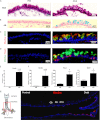Ciliated cells of pseudostratified airway epithelium do not become mucous cells after ovalbumin challenge
- PMID: 23239495
- PMCID: PMC3604083
- DOI: 10.1165/rcmb.2012-0146OC
Ciliated cells of pseudostratified airway epithelium do not become mucous cells after ovalbumin challenge
Abstract
Mucous cell metaplasia is a hallmark of airway diseases, such as asthma and chronic obstructive pulmonary disease. The majority of human airway epithelium is pseudostratified, but the cell of origin of mucous cells has not been definitively established in this type of airway epithelium. There is evidence that ciliated, club cell (Clara), and basal cells can all give rise to mucus-producing cells in different contexts. Because pseudostratified airway epithelium contains distinct progenitor cells from simple columnar airway epithelium, the lineage relationships of progenitor cells to mucous cells may be different in these two epithelial types. We therefore performed lineage tracing of the ciliated cells of the murine basal cell-containing airway epithelium in conjunction with the ovalbumin (OVA)-induced murine model of allergic lung disease. We genetically labeled ciliated cells with enhanced Yellow Fluorescent Protein (eYFP) before the allergen challenge, and followed the fate of these cells to determine whether they gave rise to newly formed mucous cells. Although ciliated cells increased in number after the OVA challenge, the newly formed mucous cells were not labeled with the eYFP lineage tag. Even small numbers of labeled mucous cells could not be detected, implying that ciliated cells make virtually no contribution to the new goblet cell pool. This demonstrates that, after OVA challenge, new mucous cells do not originate from ciliated cells in a pseudostratified basal cell-containing airway epithelium.
Figures







Similar articles
-
Ultrastructure of goblet-cell metaplasia from Clara cell in the allergic asthmatic airway inflammation in a mouse model of asthma in vivo.Virchows Arch. 2004 Jan;444(1):66-73. doi: 10.1007/s00428-003-0926-8. Epub 2003 Nov 25. Virchows Arch. 2004. PMID: 14648220
-
Goblet cells are derived from a FOXJ1-expressing progenitor in a human airway epithelium.Am J Respir Cell Mol Biol. 2011 Mar;44(3):276-84. doi: 10.1165/rcmb.2009-0304OC. Epub 2010 Jun 10. Am J Respir Cell Mol Biol. 2011. PMID: 20539013
-
Pathogenesis of mucous cell metaplasia in a murine asthma model.Am J Pathol. 2003 Jun;162(6):2069-78. doi: 10.1016/S0002-9440(10)64338-6. Am J Pathol. 2003. PMID: 12759261 Free PMC article.
-
Airway basal stem cells: a perspective on their roles in epithelial homeostasis and remodeling.Dis Model Mech. 2010 Sep-Oct;3(9-10):545-56. doi: 10.1242/dmm.006031. Epub 2010 Aug 10. Dis Model Mech. 2010. PMID: 20699479 Free PMC article. Review.
-
Early events in the pathogenesis of chronic obstructive pulmonary disease. Smoking-induced reprogramming of airway epithelial basal progenitor cells.Ann Am Thorac Soc. 2014 Dec;11 Suppl 5(Suppl 5):S252-8. doi: 10.1513/AnnalsATS.201402-049AW. Ann Am Thorac Soc. 2014. PMID: 25525728 Free PMC article. Review.
Cited by
-
HSP90 inhibitor geldanamycin reverts IL-13- and IL-17-induced airway goblet cell metaplasia.J Clin Invest. 2019 Feb 1;129(2):744-758. doi: 10.1172/JCI123524. Epub 2019 Jan 14. J Clin Invest. 2019. PMID: 30640172 Free PMC article.
-
Human lung development: recent progress and new challenges.Development. 2018 Aug 15;145(16):dev163485. doi: 10.1242/dev.163485. Development. 2018. PMID: 30111617 Free PMC article. Review.
-
Proteomic characterization of Aspergillus fumigatus - host interactions using the ex-vivo pig lung (EVPL) model.Virulence. 2025 Dec;16(1):2530675. doi: 10.1080/21505594.2025.2530675. Epub 2025 Jul 15. Virulence. 2025. PMID: 40665229 Free PMC article.
-
A Single-Cell Atlas of Large and Small Airways at Birth in a Porcine Model of Cystic Fibrosis.Am J Respir Cell Mol Biol. 2022 Jun;66(6):612-622. doi: 10.1165/rcmb.2021-0499OC. Am J Respir Cell Mol Biol. 2022. PMID: 35235762 Free PMC article.
-
A revised airway epithelial hierarchy includes CFTR-expressing ionocytes.Nature. 2018 Aug;560(7718):319-324. doi: 10.1038/s41586-018-0393-7. Epub 2018 Aug 1. Nature. 2018. PMID: 30069044 Free PMC article.
References
-
- Aikawa T, Shimura S, Sasaki H, Sasaki H, Ebina M, Takishima T. Marked goblet cell hyperplasia with mucus accumulation in the airways of patients who died of severe acute asthma attack. Chest 1992;101:916–921 - PubMed
-
- Vestbo J. Epidemiological studies in mucus hypersecretion. Novartis Found Symp 2002;248:3–19 - PubMed
-
- Rogers DF. The airway goblet cell. Int J Biochem Cell Biol 2003;35:1–6 - PubMed
-
- Rogers DF, Barnes PJ. Treatment of airway mucus hypersecretion. Ann Med 2006;38:116–125 - PubMed
Publication types
MeSH terms
Substances
Grants and funding
LinkOut - more resources
Full Text Sources
Other Literature Sources
Medical
Molecular Biology Databases

